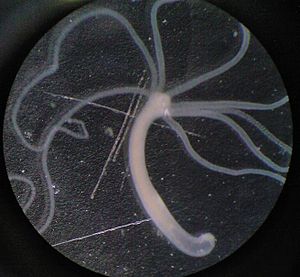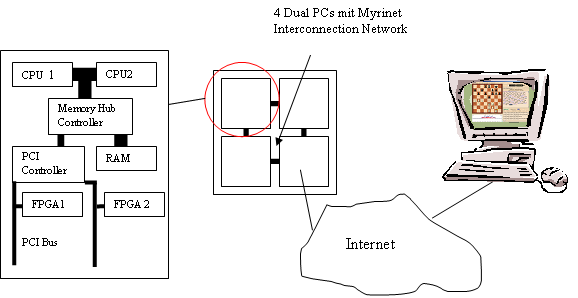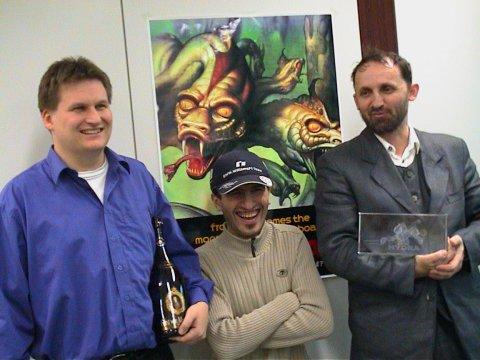Hydra
Hydra,
was a chess playing entity based on a Myrinet computer cluster consisting of FPGAs and x86 PCs.
Hydra was the continuous development of the ChessBase funded FPGA project called Brutus by Chrilly Donninger et al. now under the patronage of the Pal Group of Companies [3] and Sheikh Tahnoun Bin Zayed Al Nahyan [4] [5] [6] of Abu Dhabi, United Arab Emirates.
Contents
Tournament Play
Hydra had its tournament debut at the IPCCC 2004 winning clearly with 6½/7 ahead of Fritz and Shredder. Soon later, at the ICT 2004, Hydra came in behind Shredder, but taking revenge in August 2004, winning a match with 5½-2½. Also the IPCCC 2005 was dominated with 8/9, a half point ahead of Shredder. Hydra also achieved strong results versus humans, playing two times the Man vs Machine Team Championship, and in 2005 versus Michael Adams winning decisively with 6½-½. The chess monster further played freestyle matches along with its sponsor, chess lover and chess player under the pseudonym Zorchamp [7], and was active on the Playchess server - its last game in June 2006 [8]. In June 2009, Hydra book author Christopher Lutz stated that "unfortunately the Hydra project is discontinued." The sponsors decided to end the project [9].
System Hydra
Hydra [10] ran on a Myrinet interconnected Linux cluster of four (later eight) dual PC server nodes able to handle two PCI buses, which are conneced to a FPGA card each, simultaneously. The distributed search algorithm ran on the x86 nodes as MPI processes, where the last three plies of an n-ply search including quiescence and all evaluations are delegated to the FPGA card, typically 100.000 times per second and processor. For further information see the description of Brutus.
Team Hydra
2006
- Chrilly Donninger - chief programmer
- Abdul Mateen Khan - lead programmer
- Mohammed Nasir Ali - project manager
- Sajeer Mohammed - "Mr. Parallel"
- Arno Nickel - chess consultant
2008
The Hydra team, led by Abdul Mateen Khan, was working on two new chess projects: Cryptic and Shark, as in 2008 mentioned on the now defunct Hydra site, and from May 2008 until December 2009 on Wikipedia [11] [12]:
- Cryptic runs on modern high speed multi-processor CPU. It is programmed in mixed C and Assembly Language. It is aimed to be the world's top single machine Chess Engine.
- Shark is network based deep search meta engine. It is based on unique idea by which it reaches to depth of 25+ easily with the help of only 6 CPUs in less than a minute. Currently a dual core CPU takes more than an hour to reach to this depth.
Former Members
- Ulf Lorenz - parallel computing
- Christopher Lutz - opening book author
- Erdogan Günes - opening book author
Photos
Hydra team 2004: Ulf Lorenz, Erdogan Günes and Chrilly Donninger, IPCCC 2004 [13]
Namesake
Another program by Donninger and Alex Kure was also named Hydra and played the 15th World Microcomputer Chess Championship in Paris 1997.
See also
Publications
- Chrilly Donninger, Ulf Lorenz (2004). The Chess Monster Hydra. Field Programmable Logic and Application, Springer, pdf
- Abstract
- With the help of the FPGA technology, the boarder between hard- and software has vanished. It is now possible to develop complex designs and fine grained parallel applications without the long-lasting chip design cycles. Additionally, it has become easier to write coarse grained parallel applications with the help of message passing libraries like MPI. The chess program Hydra is a high level hardware-software co-design application which profits from both worlds. We describe the design philosophy, general architecture and performance of Hydra. The time critical part of the search tree, near the leaves, is explored with the help of fine grain parallelism of FPGA cards. For nodes near the root, the search algorithm runs distributed on a cluster of conventional processors. A nice detail is that the FPGA cards allow the implementation of sophisticated chess knowledge without decreasing the computational speed.
- Carl Bicknell (2004). Interview with Chrilly Donninger, Subject: Hydra. Selective Search 113, pp. 19, pdf hosted by Mike Watters
- Chrilly Donninger, Ulf Lorenz (2005). The Hydra project. Xcell Journal, Issue 53, pp. 94–97, pdf
- ChessBase, the Editor, John Nunn, David Levy (2005). Adams Outclassed by HYDRA. ICGA Journal, Vol. 28, No. 2
- David Levy (2005). Man vs. Machine – What Next? ICGA Journal, Vol. 28, No. 2
- Peter Vossen (2007). Computer-WM Amsterdam. Computerschach und Spiele Online, pdf1 [14]
- Chrilly Donninger (2007). Flugstunden mit Ken Thompson. pdf (German)
- Ulf Lorenz, Christian Donninger, Muhammad N. Ali, Erdogan Günes, Christopher Lutz (2020). Hydra: Report and technical overview. ICGA Journal, Vol. 42, Nos. 2-3
Forum Posts
2004
- Hydra??? by Bob Durrett, CCC, February 13, 2004
- Hydra wins Paderborn by Theo van der Storm, February 15, 2004 » IPCCC 2004
- IPCCC 2004 (7) Diep vs Hydra (0-1) Commented game by Kurt Utzinger, CCC, February 15, 2004 » IPCCC 2004
- What is the purpose of Hydra? by James T. Walker, CCC, August 22, 2004
- Some remarks about Hydra in Bilbao, by Chrilly Donninger by Enrique Irazoqui, CCC, October 11, 2004 » Man vs Machine Team Championship
2005 ...
- New hydra hardware !! by Vincent Lejeune, CCC, January 31, 2005
- Re: HYDRA vs RYBKA !! by Chrilly Donninger, CCC, December 12, 2005
- Different Hydra personalities against Rybka by Chrilly Donninger, CCC, December 13, 2005
- Corr Game 3: Hydra Scylla vs. Nickel, Arno 1/2 (PGN) by Eduard Nemeth, CCC, December 16, 2005
- Topalov will play with Hydra by Lubo Lubop, CCC, February 20, 2006
- Re: I know something of Dr.Donninger by Harvey Williamson, Hiarcs Forum, October 16, 2007 [15]
External Links
Chess Entity
- Hydra (chess) from Wikipedia
- Hydrachess.com (Wayback Machine, May 18, 2008)
- Games at chessgames.com
- Nine-headed monster wins Paderborn, ChessBase News, February 15, 2004
- Hydra shocks Shredder with 2-0 lead, ChessBase News, August 16, 2004
- All about the Hydra chess project, ChessBase News, August 22, 2004
- Hydra unbeatable in Abu Dhabi, ChessBase News, August 29, 2004
- Bilbao Man vs Machine – a resume - Drama in Bilbao by David Levy, ChessBase News, October 16, 2004
- Adams vs Hydra: Man 0.5 – Machine 5.5, ChessBase News, June 28, 2005
- Hydra is the Kasparov of computers, ChessBase News, June 30, 2005
- 8:4 final score for the machines – what next? by David Levy, ChessBase News, November 24, 2005
- Zor-Champ wins Freestyle Tournament by Arno Nickel, ChessBase News, April 16, 2006
- Checkmate - Documentry on Computer Chess Part 1, 2, YouTube Videos
Misc
References
- ↑ Hydra species filmed with a binocular stereomicroscope his eyes From School hydra jellyfish Hydrozoa Flowers, Category:Hydra (genus) - Wikimedia Commons
- ↑ Lewis Wolpert, Amata Hornbruch, Mike Clarke (1974). Positional Information and Positional Signalling in Hydra. Integrative and Comparative Biology, Vol. 14, No. 2
- ↑ Pal Group of Companies
- ↑ Al Nahyan family from Wikipedia
- ↑ Hydra (chess) from Wikipedia
- ↑ The General Secretariat of the Executive Council - Abu Dhabi - Members' Profiles
- ↑ Zor-Champ wins Freestyle Tournament by Arno Nickel, ChessBase News, April 16, 2006
- ↑ Who will be the next Freestyle Champion by Arno Nickel, ChessBase News, July 05, 2006
- ↑ Hydra (chess) from Wikipedia
- ↑ Hydra (Schachcomputer) – Wikipedia.de (German)
- ↑ Hydra (chess): 13:34, 30 May 2008 by 80.227.14.13
- ↑ Hydra (chess): 13:57, 16 December 2009 by 217.165.22.102
- ↑ Die Internationalen Paderborner Computerschachmeisterschaften by Mathias Feist, ChessBase Nachrichten, February 17, 2004 (German)
- ↑ Part 1 has an interview with Chrilly Donninger about Hydra
- ↑ quoted with the kind permission of Chrilly and Enir » Rybka


